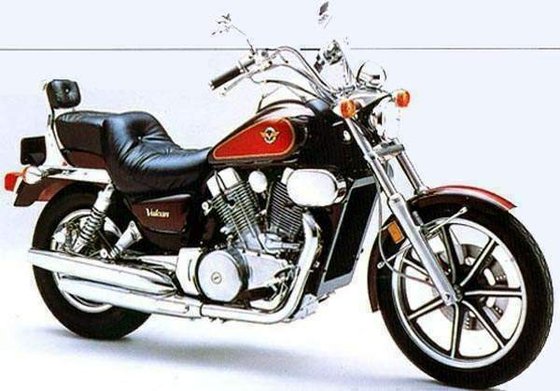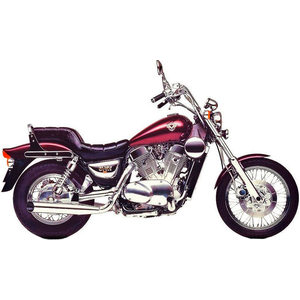Kawasaki VN 1500 Vulcan (1988-1989): A Timeless Cruiser with Muscle and Grace

Introduction
The Kawasaki VN 1500 Vulcan represents a bold chapter in cruiser motorcycle history. Introduced in 1988, this liquid-cooled V-twin beast arrived at a time when riders craved both classic styling and modern engineering. While its production run for this generation was brief (1988-1989), the Vulcan 1500 carved out a reputation as a torquey, comfortable, and surprisingly sophisticated machine that still turns heads today. Let’s explore what makes this cruiser a standout, even by modern standards.
Design: Classic Cruiser DNA with Japanese Flair
The Vulcan 1500’s design screams "American cruiser," but with a distinctly Japanese twist. Its 50° V-twin engine dominates the frame, flanked by valanced fenders and chrome accents that evoke 1950s hot-rod aesthetics. The low-slung seat (750 mm / 29.5 in) and pull-back handlebars create a relaxed riding position, ideal for long stretches of highway.
Kawasaki didn’t skimp on details: dual exhausts with a throaty rumble, a teardrop fuel tank (16L / 4.2 gal), and a wide rear tire (150/90-15) give it a planted, muscular stance. While the 284 kg (626 lb) wet weight is substantial, the bike’s low center of gravity makes it surprisingly manageable at parking speeds.
Engine & Performance: Torque Over Top Speed
At the heart of the Vulcan 1500 lies a 1,470 cc liquid-cooled V-twin – a rarity in an era when air-cooled engines dominated the cruiser segment. With 60.9 hp (44.5 kW) and a stump-pulling 117.6 Nm (86.7 lb-ft) of torque peaking at just 3,300 rpm, this bike prioritizes low-end grunt over outright speed.
Riding Impressions:
- Acceleration: The Vulcan isn’t quick off the line by sportbike standards, but the torque surge from idle makes it feel effortless in city traffic. The ¼ mile time of 13.5 seconds (155.4 km/h / 96.5 mph) underscores its muscular character.
- Top Speed: Capable of 177 km/h (110 mph), though vibrations and wind blast make sustained high-speed riding less comfortable.
- Refinement: The SOHC 4-valve heads and hydraulic lifters eliminate manual valve adjustments, while liquid cooling ensures consistent performance even in traffic.
The 4-speed transmission and shaft drive deliver smooth power delivery, though the gearbox can feel clunky compared to modern 5- or 6-speed units.
Handling: A Gentle Giant
Don’t expect canyon-carving agility here. The Vulcan’s 1,665 mm (65.5 in) wheelbase and 177 mm (6.9 in) of trail prioritize stability over flickability.
Key Notes:
- Suspension: The 41mm telescopic forks (150mm travel) and preload-adjustable rear shocks (100mm travel) handle bumps competently but feel soft during aggressive cornering.
- Brakes: Single discs front and rear provide adequate stopping power for casual riding, though modern riders might crave dual front discs for added confidence.
- Tires: The 19-inch front and 15-inch rear wheels demand deliberate steering inputs but contribute to the bike’s laid-back cruising demeanor.
Competition: How It Stacks Up Against Rivals
In the late ’80s cruiser market, the Vulcan 1500 faced stiff competition:
| Model | Key Differences | Advantage for Vulcan 1500 |
|-------------------|----------------------------------------------|------------------------------------------|
| Harley-Davidson FLSTF Fat Boy (1990) | Air-cooled, chain drive, iconic styling | Liquid cooling, lower maintenance |
| Honda Shadow 1100 | Smaller engine, chain final drive | Shaft drive, torque advantage |
| Yamaha Virago XV1100 | Lighter weight, sportier handling | Superior highway stability |
The Vulcan’s liquid cooling and hydraulic lifters gave it a technological edge over air-cooled Harleys, while its shaft drive outshone chain-driven rivals like the Honda Shadow in low-maintenance appeal. However, it lacked the brand cachet of Harley-Davidson and the nimbleness of smaller Japanese cruisers.
Maintenance: Keeping the Vulcan 1500 Road-Ready
As a MOTOPARTS.store journalist, I’ve seen firsthand how proper care extends this cruiser’s lifespan. Here’s what owners should prioritize:
Critical Maintenance Tips:
- Oil Changes: Use SAE 10W-40 (2.7L with filter). The hydraulic lifters depend on clean oil – neglect this, and you’ll hear valve train noise.
- Cooling System: The 2.3L liquid-cooling system requires annual coolant flushes to prevent corrosion.
- Shaft Drive: Replace the SAE 90W GL5 gear oil (200ml) every 16,000 km (10,000 miles).
- Tire Pressure: Maintain 2.0 bar (29 psi) front and 2.3 bar (33 psi) rear for optimal wear.
- Brake Fluid: Flush DOT 4 fluid every 2 years to prevent moisture buildup.
Common Upgrades at MOTOPARTS.store:
- Exhaust Systems: Boost the V-twin’s rumble with aftermarket slip-ons.
- Seat Cushions: The stock seat can feel firm after hours of riding.
- Brake Pads: Upgrade to sintered pads for improved stopping power.
Conclusion: A Cruiser That Ages Like Fine Whiskey
The Kawasaki VN 1500 Vulcan isn’t about cutting-edge tech or razor-sharp handling. It’s about the visceral thrill of a massive V-twin, the comfort of a well-sorted chassis, and the pride of owning a motorcycle that blends American cruiser soul with Japanese reliability. While later models introduced fuel injection and more power, this 1988-1989 generation remains a pure, unadulterated expression of what made big-bore cruisers great.
For owners looking to preserve or enhance their Vulcan 1500, MOTOPARTS.store offers everything from OEM-spec maintenance kits to performance upgrades – ensuring this classic cruiser continues to turn miles into smiles for decades to come.
Specifications sheet
| Engine | |
|---|---|
| Stroke: | Four-stroke |
| Ignition: | CDI |
| Max power: | 44.5 kW | 60.0 hp |
| Max torque: | 117.6 Nm |
| Fuel system: | 2x Keihin CV 40mm carburetor |
| Max power @: | 4300 rpm |
| Displacement: | 1470 ccm |
| Max torque @: | 3300 rpm |
| Configuration: | V |
| Cooling system: | Liquid cooled |
| Compression ratio: | 8.8:1 |
| Number of cylinders: | 2 |
| Dimensions | |
|---|---|
| Wheelbase: | 1665 mm (65.5 in) |
| Dry weight: | 252 |
| Wet weight: | 284 |
| Seat height: | 750 mm (29.5 in) |
| Ground clearance: | 177 mm (6.9 in) |
| Fuel tank capacity: | 16 L (4.2 US gal) |
| Drivetrain | |
|---|---|
| Final drive: | shaft |
| Transmission: | 4-speed |
| Maintainance | |
|---|---|
| Rear tire: | 150/90-15 |
| Engine oil: | 10W40 |
| Front tire: | 100/90-19 |
| Brake fluid: | DOT 4 |
| Spark plugs: | NGK DPR7EA-9 or NGK DPR7EIX-9 |
| Spark plug gap: | 0.9 |
| Final drive oil: | 0.2 L SAE 90W GL5 |
| Coolant capacity: | 2.3 |
| Forks oil capacity: | 0.81 |
| Engine oil capacity: | 2.7 |
| Engine oil change interval: | Every 5000km or 2 years, whichever comes first |
| Valve clearance check interval: | Not required (hydraulic lifters) |
| Recommended tire pressure (rear): | 2.3 bar (33 psi) |
| Recommended tire pressure (front): | 2.0 bar (29 psi) |
| Additional Notes | |
|---|---|
| Idle speed: | 750-850 rpm |
| Carburetor adjustment: | 2.25 turns out (mixture screw) |
| Chassis and Suspension | |
|---|---|
| Frame: | Steel double-cradle |
| Rear brakes: | Single disc |
| Front brakes: | Single disc |
| Rear suspension: | Dual shock absorbers, adjustable spring preload, 100 mm wheel travel |
| Front suspension: | 41mm telescopic fork, 150 mm wheel travel |



















